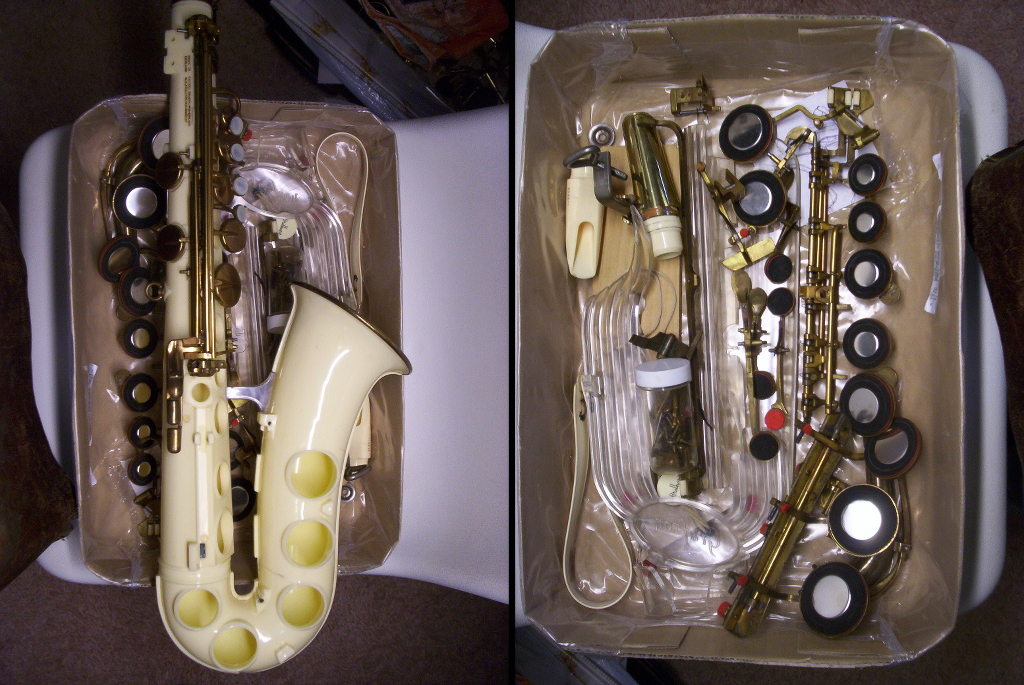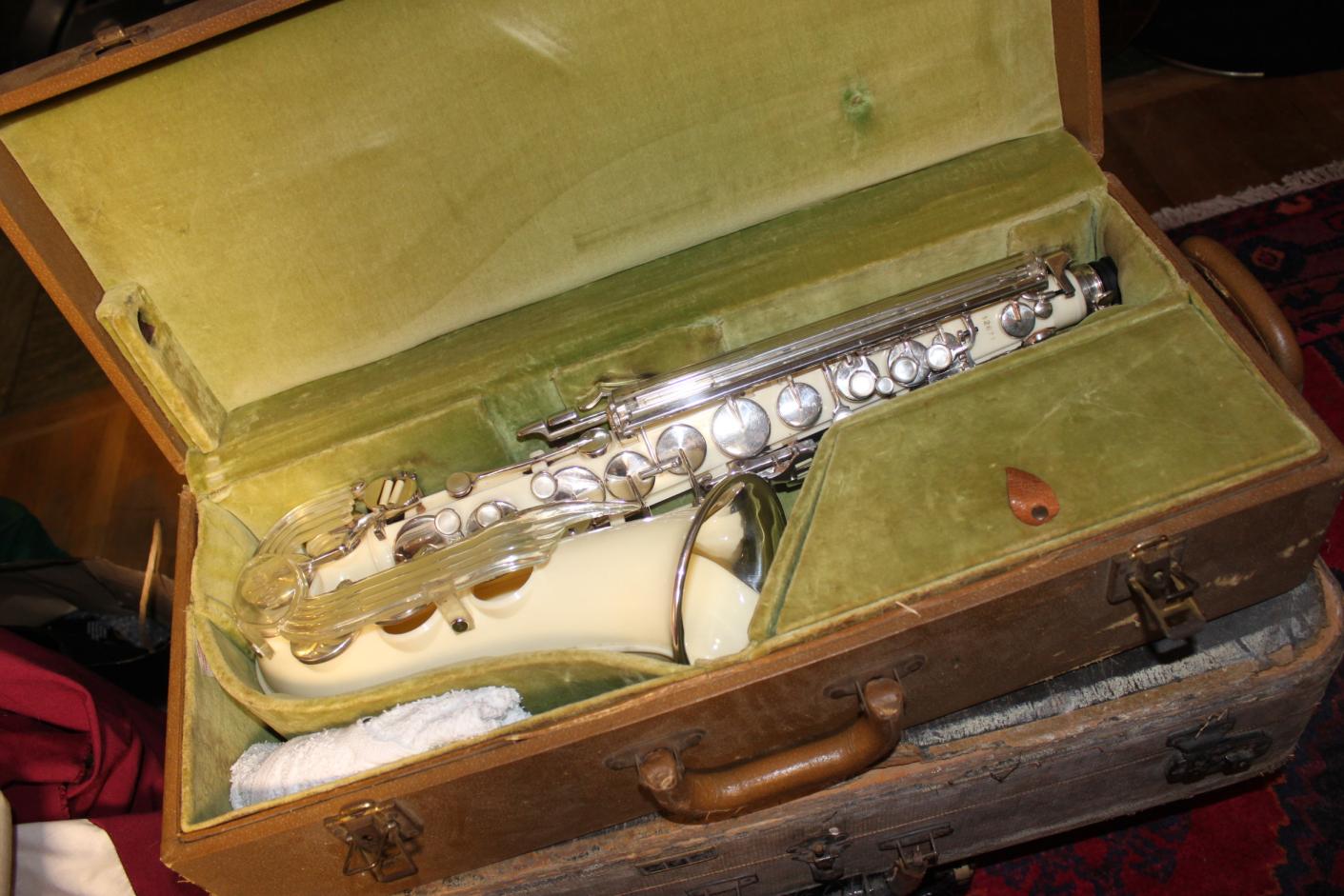Introduced: 1949
Discontinued: 1962 (production line closed in 1959; appx. 3500 horns sold)
Highest Serial Number: appx. s/n 14xxx
Original Advertised Price: 55 Guineas ($108 US; about $1029, in 2012 dollars)
Current Value: appx. $3000 US
Stephen Howard Woodwinds A review of the Grafton from a repairman’s perspective. Lots of great pics.
Stephen Howard Woodwinds: The Naked Grafton A longer article introduced on SOTW by Pete Thomas.
Wikipedia. Of course there’s a Wikipedia article. This one is a bit light, though.
The Sax and Brass Book There is a bit of incorrect information in The Sax and Brass Book, but it’s nice that a portion of the book is online.
Dave Gelly Article As mentioned in the below article.
Saxophone.org Gallery Some horns that were formerly on Saxquest’s website.
The Vintage Saxophone Gallery This is the direct link to the Grafton section of Saxpics.com’s (my old) Gallery.
Willem Alink’s Custom Graftons. Nice work.
Grafton Repair Part I of a two-part video from Mark Farmer of BAC Horn Doctor.
Restauración saxo alto GRAFTON Mostly static images, but a nice tear-down.
The Woodwind Forum Which has the genesis of this page. I’m also an admin there.
The Grafton was also only available as an alto. I’ve heard that Hector Sommaruga, the inventor, did create a tenor prototype, but it was too heavy to hold its shape.
Finally, the Grafton is also the first sax you have to worry about shattering if you drop it.
Grafton Acrylic Alto, taken apart. From Willem Alink.
Construction
Another unusual part of the Grafton is that it doesn’t have straight springs (needle springs), it has coiled springs, like you’d find in a clickable pen. This, according to some of the Grafton owners I’ve spoken with, lends a rather unusual feel to the horn. “Kinda mushy” is the general comment. The other problem would be that coiled springs are next to impossible to adjust, so all your keys could end up with odd heights.
Quoting from the Horwood article:
The other difference was more of a concern to a saxophone player used to a metal instrument. Needle springing was, for technical reasons, impossible and was replaced by a system of piano-wire springing which led to a completely different ‘feel’ for the action. Because the springing was lighter in tension, there was, theoretically at least, the possibility of a much faster technique on the Grafton. But it was essentially a different technique and it meant that it was almost impossible to transfer finger dexterity to a conventional instrument without a great deal of reorientation. Towards the end, for some reason, I found that this lack of resistance in the action was something that began to bother me and I was eventually tempted back to a conventional sax.
Note that the Grafton is a combination of plastic body and brass keywork, with a brass neck. I’ve read some comments that suggest that a neck really does have a significant impact in the overall tone of the horn. Perhaps a plastic neck made the horn sound a bit too “buzzy.” I also could think that there’s another practical reason: considering that the horn, overall, is fragile and the neck gets a lot of use, it could be that one of the designers said, “Mmmm. Let’s not do the plastic neck, after all”.
Grafton Acrylic Alto spare body tube. From Saxophone.org.
Let me quote from Roy Wood, who was the gentleman in charge of Grafton production in 1953 (he’s quoted in the above Dave Gelly article):
“The Grafton was not an easy thing to manufacture. The plastic body was injection-moulded and some of the holes had to be drilled out and filed by hand. The keys came as rough casting and they had to be smoothed off, fitted with pads and springs, polished, gold lacquered and mounted — all by hand. It was a slow job, but if you tried to rush it you broke something; then you’d have to cement the broken bit and wait for it to harden. We had a whole assembly line doing the work, but we never managed more than about 20 completed instruments a week. The average was around 12.”
The original order had been for enough parts to make 3000 instruments, with a few extra bits for spares, but when Dallas closed down the Grafton production line in 1959, nothing like that number had actually been completed. By this time Roy Wood had left, and the company arranged for him to build Graftons on a freelance basis using the left-over parts.
“For a couple of years, right up to until late 1961, I made up one or two a week in my garden shed. In the end they wanted to get shut of the whole thing and offered to sell me the remaining parts, but they weren’t complete sets and couldn’t have been made up into instruments. So I turned it down and they junked the lot for scrap. Except for this … [s/n] 13082 [alto.]”
Grafton Acrylic Alto. Rare silver plated variant. From quinntheeskimo on eBay.
The Sound
Most people that have written to me regarding the Grafton have mentioned that it sounds … like a saxophone. This is a testament and tribute to the general idea behind the A. Sax design: if use this bore design, it’ll sound like a saxophone, regardless of what material the horn is made out of. In the case of the Grafton, some people have noted that the horn sounds a tad buzzy, but it still sounds like a sax. (You do have to keep in mind that the Grafton was marketed as a student-model horn, too.)
While there are definitely a lot of extremely talented players that have played these horns, you have only two that are really “known” for playing them: Ornette Coleman and Charlie Parker — and the latter had his horn sold at auction awhile back for the whopping sum of $144,000 US (serial number 10,265, by the way).


